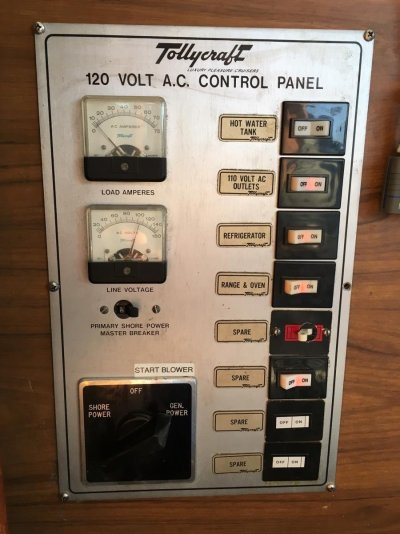Our 1977 Tollycraft has good ol' Professional Mariner, 40 amp, 120 v single stage, house bank battery charger. Well... she went caput this Labor Day week on the water. So... batts no longer can be charged via using gen set, but rather with starboard motor's alternator.
All n' all that's OK if/when cruising for hour or more... but pia (and uses more fuel) when needing to run stbd engine every day while at anchor. That's what we did during mostly anchored days... while swimming, relaxing, and BBQing during this seven day vacation.
I'm seeking another really good single stage (in other words "on" or "off" full out put mode) battery charger. Would like to get into the 60 amp charger category this time. Don't know if single stage (on/off by breaker switch) chargers are even made anymore??
Reason for single stage is because we never leave our boat plugged into dock while away form it for any period longer than couple hours, and, we only want a charger on or off when we flip it's switch.
Any suggestions on the best quality "single stage" batt chargers??? The one that just went caput is 39 yrs used this year... pretty darn good if you ask me! Of course it might be the regulator that went bad... but what the heck... after 39 years a new charger is in the offing!
Photos show elect panel's gauges, charge amp inputs via engine alternator and via old charger. Seven year old wet cell House Bank reached well over 100% charge and settled down to 100% couple hours later.
All n' all that's OK if/when cruising for hour or more... but pia (and uses more fuel) when needing to run stbd engine every day while at anchor. That's what we did during mostly anchored days... while swimming, relaxing, and BBQing during this seven day vacation.
I'm seeking another really good single stage (in other words "on" or "off" full out put mode) battery charger. Would like to get into the 60 amp charger category this time. Don't know if single stage (on/off by breaker switch) chargers are even made anymore??
Reason for single stage is because we never leave our boat plugged into dock while away form it for any period longer than couple hours, and, we only want a charger on or off when we flip it's switch.
Any suggestions on the best quality "single stage" batt chargers??? The one that just went caput is 39 yrs used this year... pretty darn good if you ask me! Of course it might be the regulator that went bad... but what the heck... after 39 years a new charger is in the offing!
Photos show elect panel's gauges, charge amp inputs via engine alternator and via old charger. Seven year old wet cell House Bank reached well over 100% charge and settled down to 100% couple hours later.







